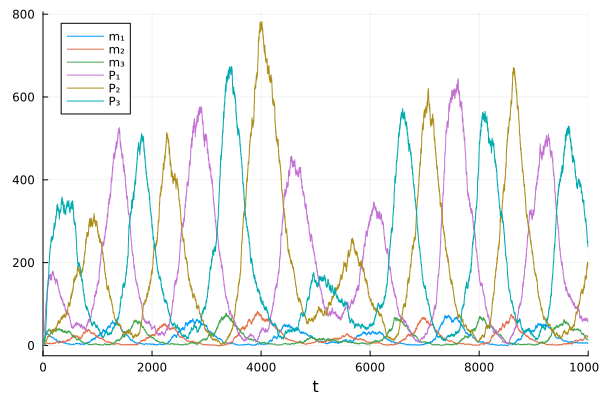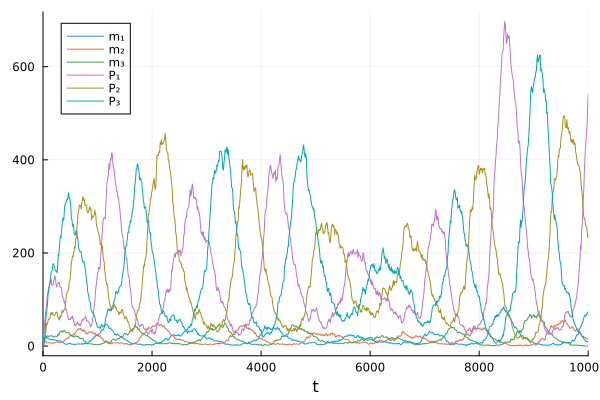Stochastic modeling in Catalyst#
Repressilator SDE#
using Catalyst
using ModelingToolkit
using StochasticDiffEq
using JumpProcesses
using Plots
Model is the same as building the ODE problem
repressilator = @reaction_network begin
hillr(P₃, α, K, n), ∅ --> m₁
hillr(P₁, α, K, n), ∅ --> m₂
hillr(P₂, α, K, n), ∅ --> m₃
(δ, γ), m₁ ↔ ∅
(δ, γ), m₂ ↔ ∅
(δ, γ), m₃ ↔ ∅
β, m₁ --> m₁ + P₁
β, m₂ --> m₂ + P₂
β, m₃ --> m₃ + P₃
μ, P₁ --> ∅
μ, P₂ --> ∅
μ, P₃ --> ∅
end
@unpack m₁, m₂, m₃, P₁, P₂, P₃, α, K, n, δ, γ, β, μ = repressilator
p = [α => 0.5, K => 40, n => 2, δ => log(2) / 120, γ => 5e-3, β => 20 * log(2) / 120, μ => log(2) / 60]
u₀ = [m₁ => 0.0, m₂ => 0.0, m₃ => 0.0, P₁ => 20.0, P₂ => 0.0, P₃ => 0.0]
6-element Vector{Pair{Symbolics.Num, Float64}}:
m₁(t) => 0.0
m₂(t) => 0.0
m₃(t) => 0.0
P₁(t) => 20.0
P₂(t) => 0.0
P₃(t) => 0.0
Convert the very same reaction network to Chemical Langevin Equation (CLE), adding Brownian motion terms to the state variables.
Build an SDEProblem with the reaction network
tspan = (0.0, 10000.0)
sprob = SDEProblem(repressilator, u₀, tspan, p)
sol = solve(sprob, LambaEulerHeun())
plot(sol)

Using Gillespie’s stochastic simulation algorithm (SSA)#
Create a Gillespie stochastic simulation model with the same reaction network. The initial conditions should be integers.
u0 = [m₁ => 0, m₂ => 0, m₃ => 0, P₁ => 20, P₂ => 0, P₃ => 0]
6-element Vector{Pair{Symbolics.Num, Int64}}:
m₁(t) => 0
m₂(t) => 0
m₃(t) => 0
P₁(t) => 20
P₂(t) => 0
P₃(t) => 0
Create a discrete problem because our species are integer-valued:
dprob = DiscreteProblem(repressilator, u0, tspan, p)
DiscreteProblem with uType Vector{Float64} and tType Float64. In-place: true
timespan: (0.0, 10000.0)
u0: 6-element Vector{Float64}:
0.0
0.0
0.0
20.0
0.0
0.0
Create a JumpProblem, and specify Gillespie’s Direct Method as the solver.
jprob = JumpProblem(repressilator, dprob, Direct(), save_positions=(false, false))
JumpProblem with problem DiscreteProblem with aggregator JumpProcesses.Direct
Number of jumps with discrete aggregation: 3
Number of jumps with continuous aggregation: 0
Number of mass action jumps: 12
Solve and visualize the problem.
sol = solve(jprob, SSAStepper(), saveat=10.0)
plot(sol)

This notebook was generated using Literate.jl.
